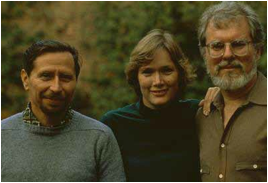by Sunny Jung Scully
August 2010

Here are a few thoughts as I look back on my time with Jim and Wolfgang (1981-85)
As the first trained landscape architect in the office, I was initially amazed at the lack of formal plans and specifications to guide the quality of garden production. However, I did find that what existed was a partnership that set the tone for all the success that would follow. Jim was a great designer- he could have made a success at designing anything. He simply had good taste, and the confidence to sell his ideas to just about anyone. Wolfgang lived to explore the nature of arranging plants. My entree into their world came from my background in Wisconsin- working with native prairie restoration and grasses.
We worked from the basement of Jim's Georgetown townhouse. As a client showed interest- Jim would set us to creating sketch concepts. Sometimes that's all we relied upon to build those early gardens. It was a design - build operation. We were very hands-on in approach, and the early designs leaned heavily on their plantings for expression. Hardscapes were simple local materials laid out to feature or showcase lush gardens. While we expressed the scope to the contractor, we always were present on the job- laying out, placing everything and adjusting as we went. Most clients trusted us to create a special work of art for them, and budgets were generally set to allow some latitude. We all sort of felt our way into those early projects and learned a great deal from the experience. I remember the three of us scattering and planting several thousand fall bulbs on a job. We felt that is was easier and better to do it ourselves than try and explain it to a contractor. We cared about intersecting patterns of color and the succession of bloom times. My hands and back were sore for days. But I learned so much about building gardens from them. The level of sophistication kept increasing every year.
Wolfgang wasn't happy unless he had total control to move things around till they were happy in their setting. Having been part of the horticultural extravaganza in Berlin- he was ever exploring new plants to introduce. While there were many wonderful outcomes- there were also a few hard lessons such as Heracleum, which was terribly invasive and physically painful to control. He eventually formed a fine relationship with grower, Kurt Bluemel- who made the transition of providing quantity and quality of these new plants. This provided a springboard for using large quantities of perennials and grasses. In the early '80's, there were few non- traditional plant types available. It's really amazing how rapidly the nursery industry jumped to provide what we now take for granted in the plant palette of available species. Everyone wanted to learn, once they'd seen plantings survive and succeed in these unique new designs that the firm was producing. Not everything thrived, but we faithfully returned and nurtured the clients so that solutions were forthcoming that resolved most issues. It was a marvelous time to work with these men, as everyone had a chance to try out ideas.
In those early days, the firm relied primarily on residential projects. Few commercial clients at that time were interested in the maintenance and special qualities of these fine gardens. The Federal Reserve was one of those rare exceptions, and that was due to the backing of the chairman, who (at the instigation of his wife) took great interest in having a unique statement for their headquarters after a disastrous winter that killed most of their traditional southern plantings. There were several large projects, but it was generally more difficult in those days to produce the specifications, as we were just figuring out many of the techniques, and it didn't lend itself to the general contractor bidding process. Those things changed with a growing sophistication in the market place. But in the early years, it was far easier to control the outcome when all the variables were under the firm's control in the contracts.
One of the greatest pleasures for me was working with Jim as art was introduced into the garden. Always an ardent supporter of the arts- it was wonderful to see Jim's flamboyant insistence on working with sculptors and artists. While viewing their own work as a masterpiece- it was seldom considered finished without the interplay of water and sculpture. The nature of creating a special place was how they viewed every project. Their gardens express a unique quality that sets them apart from most. It takes a masterful touch to get the massing and materials coordinated properly. Most of their gardens are imminently photogenic from many points, which has led Jim to create the books and articles that express their principles. He learned from some good photographers, and then achieved best results by teaching the new generation of photographers what he wanted to see in the way of light, focus and mystery. He has used his fine design talents to make those books beneficial to our profession, yet intriguing and useful to the general public. The level of interest in planting design has been significantly raised by the firm's work and subsequent visibility. Their niche grew beyond anything they might have imagined, and landscape architects have a far richer palette to draw upon expressly because they pursued their vision so diligently.